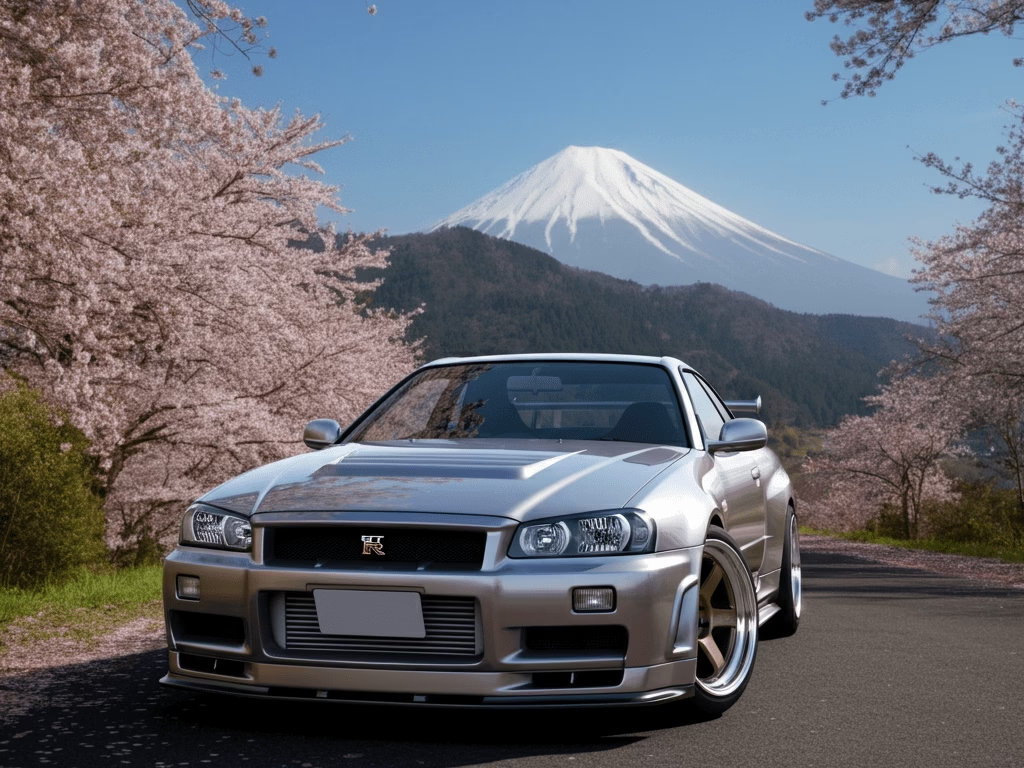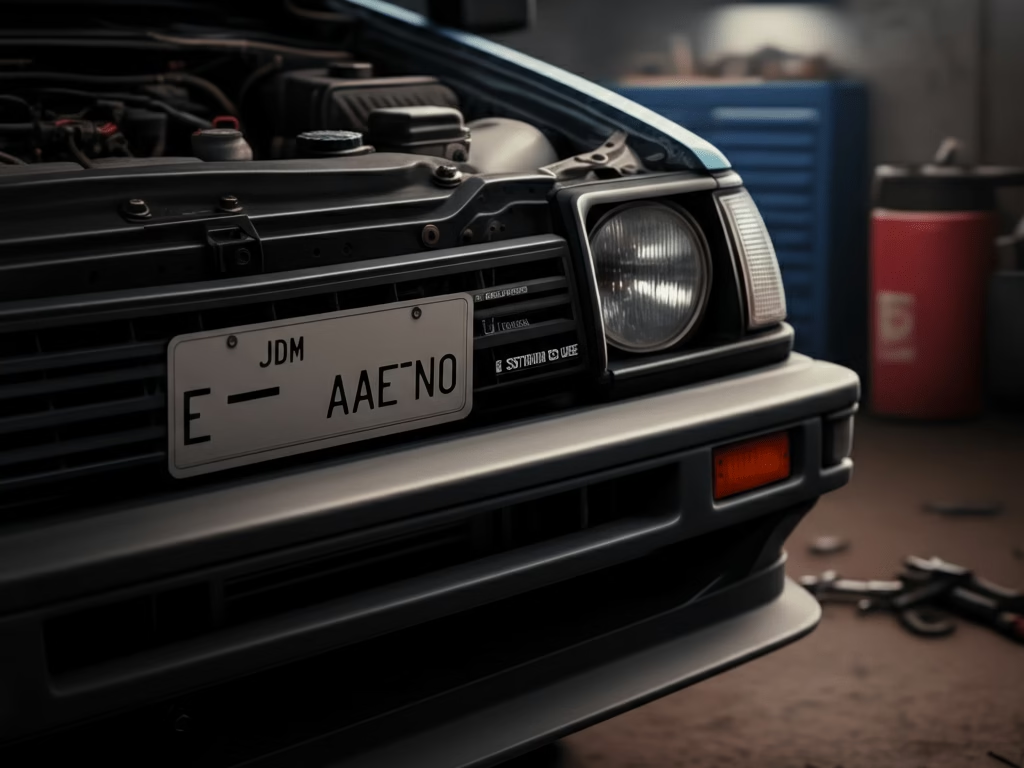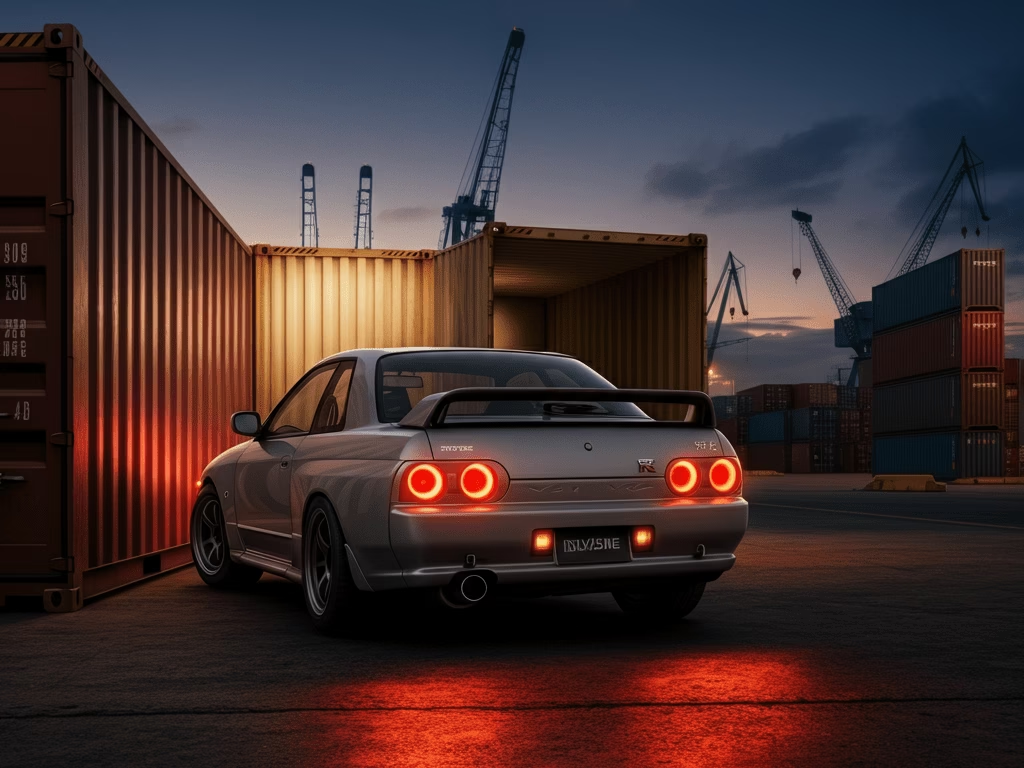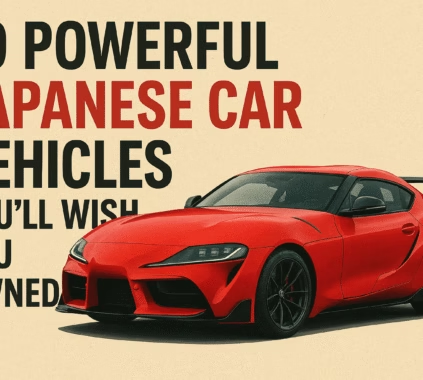Car culture is vast, but “JDM” always stands out. For many, it sparks images: towering Supra spoilers, nimble Honda Civics at apexes, and the growl of a Nissan GT-R in mountain tunnels.
Table of Contents
But what does JDM Cars Full Form mean? Simply, “Japanese Domestic Market.”
That three-word answer is a ticket into a world of legendary machines, unique philosophies, and a lifestyle beyond the showroom.
Knowing the JDM cars full form brings you to a culture of precision engineering, bold innovations, and a distinct look.
These cars aren’t just built in Japan they’re tailored for Japanese buyers, with creative limits you won’t find elsewhere.
This article digs deeper into the JDM Cars Full Form to reveal the appeal behind these legends.
We’ll share seven key points highlighting what makes JDM cars unique, how they differ from export models, and the market’s influence on global car culture.
1. JDM Is About More Than Being Made in Japan

This section clears up a basic misconception: not every Japanese car is JDM. JDM Cars Full Form stands for Japanese Domestic Market, representing vehicles made specifically for Japanese buyers and regulations.
Think of it this way: USDM stands for United States Domestic Market, meaning vehicles made for U.S. customers and regulations.
EUDM means European Domestic Market for vehicles meant for European buyers. A true JDM model is one that was built to meet Japanese safety and market requirements, sold new at a Japanese dealership, and not originally intended for export.
This section highlights why true JDM status matters. Unique features, engines, and options distinguish JDM models from exports, making them especially desirable to dedicated fans.
Example: the Nissan Skyline GT-R R34 is a genuine JDM icon, built for Japanese roads and drivers.
In contrast, the Nissan Rogue, designed for North America, lacks JDM status proving the term ‘Domestic’ defines the market and appeal.
When you get deeper, the whole “JDM Cars Full Form” label reveals unique characteristics found only in cars, parts, or models specifically made to meet Japanese regulations and consumer taste. “Full form” here simply means the complete definition of what JDM stands for, not just the acronym.
- True JDM Gems: Many greats never left Japan. The pre-R35 GT-R, the EK9 Civic Type R, and the Toyota Century were sold only domestically, best enjoyed on Japan’s challenging roads.
- Here, explore ‘Reverse JDM’: sometimes, American-branded cars are adapted for Japan and meet JDM definitions, like the Ford Probe, which gained unique features and market entry.
In summary, remember: JDM Cars Full Form means ‘Japanese Domestic Market.’ Focus on the target market, not the brand, to understand JDM culture.
2. The “Gentlemen’s Agreement” Shaped a Generation of Performance

One of the coolest stories from JDM Cars Full Form Or Japanese car history is the untold “Gentlemen’s Agreement.”
Back in the late 1980s, car makers started getting nervous. Traffic accidents were rising, and they knew stricter rules might be just around the corner.
To avoid heavy government regulations, the Japan Automobile Manufacturers Association (JAMA) made a quiet deal.
The big brands promised never to advertise more than 280 PS (what is just a tiny bit over 276 horsepower) for any new car sold on Japanese turf.
From 1989 to 2004, that number appeared on brochures everywhere. But here’s the surprising twist: nobody slammed the brakes on innovation.
The horsepower cap lit a spark of creativity. Engineers now chased the number on the paper, but they chased it a different way.
Instead of one more turbo, they hunted lighter curb weights, tighter body structures, and torque that stuck the car to the road. So, what were the coolest outcomes?
- Chassis and Suspension: Say hello to multi-link badges from your favorite brands. Engineers switched to multiple-link designs and pressed lighter, stiffer platforms into service. The goal? Grip and feedback that made every twist of the wheel feel live and direct.
- Advanced Technologies: Things like all-wheel-drive didn’t just get names slapped on the fenders. Nissan’s ATTESA E-TS and Mitsubishi’s Super All-Wheel Control (S-AWC) took data, sent it to all four corners, and made sure the car danced instead of fumbled. And Honda’s Precision All-Wheel Steering (P-AWS) toed the technical line, allowing rear wheels to turn a tick, changing angles in sync with steering for cornering that emptied jaws.
Engine Durability and Tunability
Even though brochures claimed 276 hp, lots of JDM Cars Full Form legends actually came with stealthy excess power.
Take the 2JZ-GTE from the Toyota Supra and the RB26DETT from the Nissan Skyline GT-R. Many dyno tests showed these motors pushing 300+ hp straight from the assembly line.
With bulletproof internals and turbos the size of small asteroids, tuners saw massive room for improvement, not just replacement.
Japan’s Gentlemen’s Agreement felt like a limitation on paper, yet it did the opposite in practice.
Car makers suppressed power figures just enough to stay polite in the board rooms, so engineers had to excel in refining balance and responsiveness.
Instead of the usual horsepower race, the focus became torque curves, spool times, and weight distribution.
For anyone who’s torn down a JDM Cars Full Form classic, the so-called cap was really a hidden challenge, and a final exam that left the wilting silhouette of a showroom queen for a well-balanced competitor.
3.Kei Cars The Tiny Titans of the Japanese Domestic Market

While screaming Supras and Skylines get web-meme glory, the true OGs of the JDM Cars Full Form “Japanese Domestic Market” are the Kei cars.
Kei means ” light vehicle “it is a category of small, lightweight cars defined by strictly regulated dimensions and engine size for use in Japan.
These regulations were created to fit urban needs and give tax incentives.
Engineers deliver impressive creativity within these compact cars. Some features, like faux spoilers and flip-up headlamps, serve both functional and aesthetic purposes.
Their small size suits urban areas, while spacious interiors provide surprising comfort. Kei cars boldly confront Japan’s tight parking regulations with ingenuity, making the most of every centimeter.
Kei regulations set some tight limits on these pint-sized cars:
- Length: 3.4 m (11.2 ft)
- Width: 1.48 m (4.9 ft)
- Height: 2.0 m (6.6 ft)
- Engine: 660cc (0.66 liters)
Stay within these limits, and the government offers tax and insurance breaks. These cars fit Japan’s busy city grids and rural lanes.
Kei cars may look basic, but they’re some of the cleverest, most exciting JDM Cars Full Form entries in the world.
Take the legendary “ ABC ” trio of the early ’90s:
- A – Autozam AZ-1: This mid-engine gem, designed by Mazda, flaunts sporty gullwing doors.
- B – Honda Beat: A breezy rear-drive convertible that revs like a motorcycle and sounds the part.
- C – Suzuki Cappuccino: A rear-drive drop-top packing a front engine and a clever target top that pops off for even more open-air fun.
These cars demonstrate that exciting driving doesn’t require a large engine. They highlight the Japanese philosophy that less can be more, offering an enjoyable experience without excess.
Kei cars embody the idea of a JDM Cars Full Form “small but mighty” vehicle. Designed for Japan’s compact cities and lively streets, they are charming and quick. New Kei models can be found on Daihatsu’s Japan website.
4. VIN vs. Chassis Code Know Your JDM Badge

In the U.S. and Europe, cars use a 17-digit Vehicle Identification Number (VIN) to identify important information like country of manufacture, model, and year.
JDM vehicles, by contrast, primarily use a shorter Chassis Code (also called a Frame Number) as their unique identifier, like “E-AE86” or “GF-EK9,” to indicate the model and specific variant.
Take “E-AE86.” This string points to a 1980s Toyota Sprinter Trueno or Corolla Levin, models that the touring and drift world can’t quit raving about.
The “AE86” is what car lovers often shout when the headlights kick on, and the fun kicks up.
GF-EK9: This code stands for the iconic 1999-2000 Honda Civic Type R, with “EK9” marking it as the turbocharged standout of the Vogue series.
Some folks see it as trivia, but that’s the biggest mistake you can make knowing the chassis code is a must if you’re thinking about importing or authenticating a real JDM ride.
Because the EK9 skips the standard 17-digit VIN, that’s your easy red flag: it’s a factory Japanese-market car.
This chassis-letter deep dive is practically hazing for die-hard JDM enthusiasts: nail it, and you instantly know model, trim, and even the assembly month.
It compresses the blueprint of the Type R into six characters that every owner should know by heart.
When a JDM Civic Type R finally touches down overseas say, at a California port state DMV clerks slap a full 17-digit VIN on the windshield for legal parking.
Still, the EK9 code is the real artifact, tucked on that tiny chassis plate. It’s the unfakeable fingerprint marking the car’s cradle with Honda, and the one detail you should scan before the paperwork even starts.
5. Shaken The Driving Force Behind Japan’s Used Car Market

Ever wonder why so many great-condition, low-mileage cars leave Japan for overseas buyers? The secret is Shaken (車検), Japan’s ultra-tight car inspection program.
It’s the main reason that lots of like-new rides appear ready to be put on a boat.
New cars get their first Shaken after just three years, and the clock starts ticking two years after that, and then every two years.
The test dives deep into almost every mechanical and safety part of the vehicle. Just the exam can set a driver back anywhere from $1,000 to $2,000.
And that’s before any repairs. The older the car, the higher the chance it will need pricey fixes to clear the tests.
Faced with these growing bills, most owners decide it’s smarter to flip their cars and grab a newer model instead of sinking money into ageing parts. The ripple effects are clear:
- A High-Quality Used Car Glut: Japan’s secondary market fills up with untarnished rides that set fresh low-mileage records before they are even offered for import.
- Routine TLC: Because drivers know Shaken is ready every three years, they stick to their service schedules. Regular oil changes, brake checks, and timing belt swaps, the stuff that makes for a great used car, become the norm.
The Rise of Export Giants
Japan’s steady supply of sought-after used cars kicked off a huge export business, sending cherished JDM Cars Full Form ” Japanese Domestic Market ” rides all over the globe to places like the U.S., Canada, Australia, and the UK.
A huge player that made this export boom possible is Japan’s Shaken system, which is a kind of strict vehicle inspection. This one-of-a-kind rule is the hidden engine that drives the JDM Cars Full Form ” Japanese Domestic market ” , letting car lovers everywhere finally own and drive these iconic rides.
Take away the Shaken, and the worldwide love for used JDM cars probably wouldn’t have happened. So the market is really a reflection of unique Japanese rules.
6. The 25-Year Rule and a Fresh Wave of JDM

For years, the hottest JDM Cars Full Form ” Japanese Domestic Market ” models felt like forbidden fruit for American gearheads.
The 1988 rule under the Imported Vehicle Safety Compliance Act made it super tricky and pricey to bring in cars that never officially arrived in the U.S.
But right in the fine print was a game-changer. Any car that hits 25 years old exactly to the month of the VIN can roll into the U.S. without having to line up with today’s safety and emissions rules.
The “25-Year Rule” is the secret formula that keeps American car fans hooked. Just when you think you’ve seen it all, another batch of iconic JDM Cars Full Form ” Japanese Domestic Market ” rides rolls up, ready for our garages.
Back in the 2010s, it opened the door to the legendary squad: early Nissan Skylines (R32), the sleek Mazda RX-7 (FD), and the curvy Toyota Supra (A80). Suddenly, fantasy cars had a legal highway in the U.S.
Zoom ahead to the 2020s, and the lineup only gets hotter. Now the R34 Skyline, both the Lancer Evolution V and VI, and the aggressive Honda Civic Type R (EK9) are coming up for adoption. Every year, a fresh wave of magic arrives at the docks.
The 25-Year Rule flipped the North American car culture on its head. Beyonder cars that once lived only on bedroom walls and in console games are now parked side by side at meets.
Right-hand-drive wonders are popping up like a hidden latest level, leaving newcomers and OGs alike in awe.
The 25-Year Rule shows us how deeply the JDM Cars Full Form ” Japanese Domestic Market ” shapes car culture even decades after the factory turns are closed.
Interest in these machines hasn’t cooled in fact, it heats up year after year. Buzz in the forums, parking lots, and meets now zooms in on the next “hero car” about to cross the quarter-century mark.
If you want to go beyond the excitement and actually bring one home, the nitty-gritty laws are spelled out on official pages like the NHTSA’s vehicle importation site.
JDM Cars full form in 2023 also comes with footnotes on paperwork, mileage, and emissions.
The cars are spectacular, but what truly fuels the flames is the lifestyle stitched into every emblem, every coil-over, every midnight lap in the hills.
JDM Cars Full Form stands for much more than “Japanese Domestic Market” on window stickers it’s a vibe, a visual language, a tightly knit worldwide fandom.
The scene started on Japan’s steep mountain touge and still rides the digital wave thanks to magazines, forums, and, of course, video reels.
Odyssey begins with manga and anime. Titles like Initial D and Wangan Midnight spotlight the art of barely-legal tuning and pedal-to-the-metal camaraderie.
Initial D didn’t just document the drift lifestyle it crowned the Toyota AE86 as a globe-trotting legend, turning a rear-wheel hatch from the ‘80s into a shrine for tuners everywhere.
Stories like these don’t just feed fandom they fuse fact with folklore, turning every import into a mobile piece of heritage.
7. Video Games

Gran Turismo made PlayStation feel like a showroom for car-loving teens. Suddenly, you could steer a fleet of JDM legends from the comfort of your living room.
Many of us learned about the latest Honda, Nissan, or Toyota prototypes by adding them to our virtual garage models we might never see in real life were faithfully recreated down to the way the headlights flicker.
Tuning and Customization
The JDM Cars Full Form ” Japanese Domestic Market ” tuning scene is like a living gallery of how you can take a factory ride and make it a rolling masterpiece.
Shops like HKS, GReddy, Spoon Sports, and Mine’s turned already awesome cars into masterpieces of performance.
Whether it’s a rough “drift missile” that looks like it just left a track day or a mirror-shined “show build” that glows in the sunlight, the variety keeps our Instagram feeds buzzing. Each car tells a different story about culture, creativity, and horsepower.
Drifting
Drifting feels like it was born in the alleyways of Japan. While cars from all over the world now slide sideways, the real heart and soul left the factory floor of Nissan and Toyota.
Rear-wheel-drive legends like the Silvia and AE86 became canvases for drivers who love the graceful art of controlled chaos.
Drifting is about feeling the corner and painting a perfect arc, proving that in some cases, style beats speed.
This whole scene is what breathes life into every silvery haunch of an S13. A Nissan Silvia S13 is more than a car it’s a donut-smoke silhouette burned into the asphalt of car culture.
A Honda Civic EG is more than a hatchback it’s a beat-up yet beloved racer painting walls in the tight turns of Osaka’s Kanjo Loop.
When the key enters the JDM ignition, it’s opening a door to an archive of mixtapes, film clips, aftermarket dreams, and bonnet stickers born overnight.
That fanatic flame is what turns a factory-spec coupe into an emblem sprinting across continents.
Conclusion More Than Four Letters
JDM Cars Full Form “Japanese Domestic Market” sounds like an export brief, yet it’s the heartbeat humming between every hatch, coupe, and sedan.
This acronym carries the weight of a hundred midnight street runs and the rumors of fairy-tale specs traded between collectors.
It captures a design creed, forged in the constraints of the 276-horsepower Gentlemen’s Agreement and the Kei car measurements that made genius fit into compact meekness.
The name spells a factory tradition that tattoos chassis codes on the firewall instead of a boring VIN, whispering pride to those who know.
It accounts for a worldwide trade ritual, hatched on the day of stricter Shaken emissions and the 25-Year rule, allowing beloved classics to skip the chopping block and instead enter the hands of admirers lighting them up with fresh dreams.
The heart of “JDM Cars Full Form ” isn’t just about market codes it’s a living culture built on love for a golden period of Japanese automotive brilliance.
Through YouTube reels, drift battles, and late-night Discord chats, fans everywhere bond over these spirited machines.
One moment you’re admiring a bone-stock A80 Supra, quietly packing a wallop, and the next you’re drawn to the featherweight, psychedelic Honda Beat that zips with that signature keijidosha charm.
When you spot a right-hand-drive beauty at a local car meet, you’re not just seeing a rare import.
You’re witnessing a slice of the JDM Cars Full Form Japanese Domestic Market Tone that carries entire decades of craftsmanship, speed, and undiluted joy rolled into its elegant chassis.














